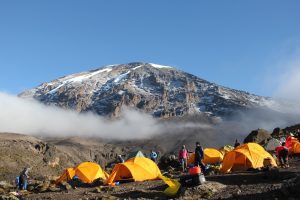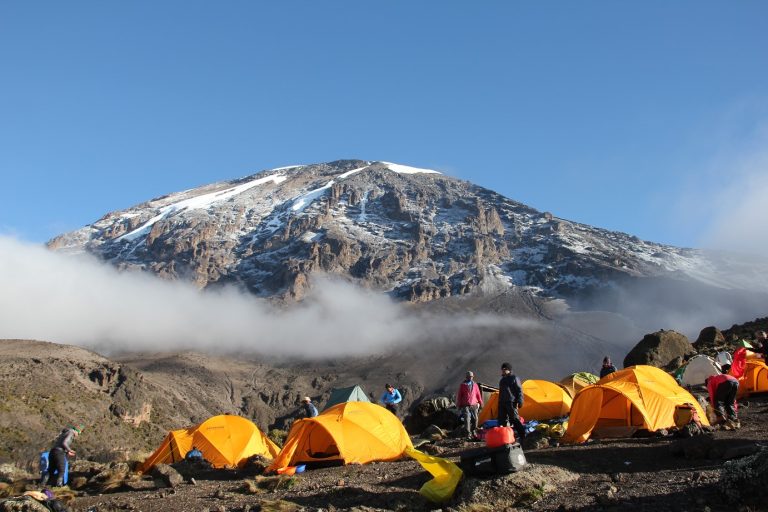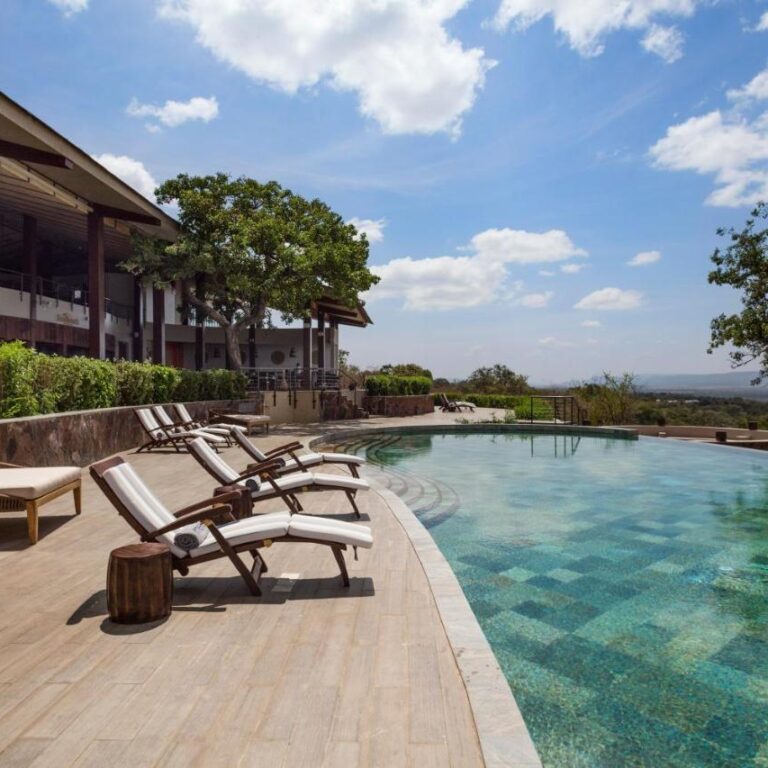Climbing Mount Kilimanjaro is an epic physical and mental challenge. At 19,341 feet, it is Africa’s highest peak and the world’s tallest free-standing mountain. As you ascend through five distinct climate zones—from lush rainforest to arctic summit—your body will be pushed to its limits. To conquer this magnificent giant, you need more than just physical fitness and mental fortitude; you need a strategic approach to nutrition. At the end of the day’s walking, afternoon tea is served with biscuits, peanuts, and, best of all, salted popcorn and plenty of hot drinks. Dinner begins with soup, followed by a main course including chicken or meat, a vegetable sauce, some cabbage, and rice, pasta, or potatoes, with fresh fruit for dessert.
What you eat on the mountain is arguably as important as the gear you pack. Proper nutrition provides the energy needed to hike for hours, helps your body acclimate to the thinning air, and aids in recovery. A well-planned menu ensures you have the stamina to reach the summit and the resilience to descend safely. Here is a guide to the nutritious food you can expect—and should prioritize—during your Kilimanjaro climb. The Guiding Principles of Kilimanjaro Nutrition
The food served on Kilimanjaro is designed to be high in carbohydrates, which are your body’s primary source of energy. With the high altitude, your body becomes less efficient at digesting fats, making a carb-heavy diet essential. You’ll also need a good intake of protein for muscle repair and recovery, and plenty of fluids to stay hydrated and ward off altitude sickness. The meals are prepared by a dedicated team of cooks who join your expedition, ensuring you receive fresh, hot, and delicious food at every camp.
1. Breakfast: The Foundation for a Full Day
Breakfast is the most important meal of the day, especially on Kilimanjaro. It provides the initial energy to tackle a day’s hike, which can range from four to seven hours. A typical Kilimanjaro breakfast is hearty and varied, designed to give you a slow-release energy boost. The golden rule for breakfast is to eat as much as you can. Even if your appetite is reduced by the altitude, try to get in as many calories as possible. You’ll be burning a tremendous amount of energy, and breakfast is your fuel. You can expect to find a mix of the following:
Porridge or Oatmeal. A staple on the mountain, porridge is an excellent source of complex carbohydrates. It digests slowly, providing sustained energy for the morning trek. Often served hot, it also helps warm you up on a chilly morning. Eggs. Whether scrambled, boiled, or as an omelet, eggs are a great source of protein and healthy fats. They contribute to a feeling of fullness and help with muscle repair.
Toast or Chapati. Served with jam, butter, or honey, bread provides quick-acting carbs to get you started. Chapati, a type of flatbread, is a local favorite and a delicious alternative. Sausages or Bacon. While not always available, some operators provide a small portion of meat to supplement the meal. These add flavor and a protein boost.
Fresh Fruit. A small bowl of fruit, like bananas, oranges, or watermelon, is often served. Fruits are rich in vitamins, minerals, and natural sugars, offering a natural energy kick. Hot Beverages. You’ll be served an array of hot drinks, including coffee, tea, and hot chocolate. While coffee and tea provide a welcome caffeine boost, it’s essential to moderate your intake as caffeine can be a diuretic. Herbal teas and hot water are always excellent choices for staying hydrated.
2. Lunch: The Midday Replenisher
Lunch on Kilimanjaro varies depending on the day’s itinerary. On shorter hiking days, you might return to a camp for a hot lunch. On longer days, your team will prepare a packed lunch that you can enjoy at a scenic spot along the trail. Regardless of whether it’s hot or packed, the lunch is designed to replenish the energy you’ve spent in the morning and prepare you for the afternoon’s hike. It’s a critical moment to hydrate and replenish calories.
Hot Lunch at Camp. If you’re back at camp, lunch its often a warm and comforting meal. Think hot soup to warm your core, sandwiches with cheese or meat, and a side of pasta or rice. This is a great opportunity to rest and refuel properly. Packed Lunch on the Trail. This usually consists of a well-balanced meal that is easy to carry and eat. Common items include: Sandwiches. Made with bread, cheese, a protein like chicken or tuna, and fresh vegetables.
Hard-Boiled Eggs. A simple and effective protein source. Fruit and Vegetables. Bananas, apples, cucumbers, and carrots are common and provide essential vitamins and fiber. Snack Bars. Granola bars or energy bars are often included for a quick energy top-up. Juice Box. A small, easy-to-carry drink to supplement your water intake.
3. Snacks: The Constant Energy Source
Snacks are your secret weapon on Kilimanjaro. They are crucial for maintaining consistent energy levels throughout the day and preventing the dreaded energy crash. Your guides will advise you to “pole pole” (slowly, slowly) and snack frequently. This helps keep your blood sugar stable and provides a constant stream of fuel for your muscles. Your tour operator will provide some snacks, but it is highly recommended to bring your own personal favorites. A steady supply of familiar snacks can make a huge difference, especially if your appetite is affected by the altitude. What to pack and what to expect:
Trail Mix. A classic for a reason. A mix of nuts, dried fruits, and seeds provides a perfect blend of healthy fats, protein, and carbohydrates. Energy Bars. Granola bars, protein bars, and energy gels are fantastic for a quick, concentrated burst of energy. Look for options with a good balance of protein and carbs.
Chocolate and Candy. Small amounts of chocolate or hard candies can be a morale booster and provide a fast-acting sugar hit when you feel your energy flagging. A small piece of dark chocolate can also be a delicious treat. Dried Fruit. Raisins, apricots, and dates are easy to eat and packed with natural sugars and fiber. Biscuits/Crackers. Simple and effective for a carb boost, especially on days when your appetite is low.
4. Dinner: The Reward and Recovery Meal
After a long day of hiking, dinner is the highlight of the evening. It’s the time to relax, share stories with your fellow climbers, and most importantly, refuel your body for the next day’s climb. Dinners on Kilimanjaro are typically warm, filling, and packed with the necessary nutrients for recovery. Dinner is your opportunity to eat a large, satisfying meal. Your body needs these calories to recover overnight, and a good meal will help you sleep better, leaving you feeling more refreshed for the next day’s climb. A typical dinner often includes:
Soup. Every dinner starts with a hot, hearty soup. This is not only a fantastic way to warm up but also helps with hydration and provides a dose of salt and nutrients. Carbohydrates. Rice, pasta, potatoes, or ugali (a traditional African maize porridge) form the base of the meal. These are essential for replenishing muscle glycogen stores depleted during the day.
Protein. A protein source like chicken, beef, fish, or lentils its always included. Protein is vital for repairing muscle tissue and preparing your body for the next day’s exertion. Vegetables. Freshly cooked vegetables such as cabbage, carrots, spinach, or green beans are served to provide essential vitamins, minerals, and fiber. Dessert. A simple dessert, such as custard, fruit, or popcorn, is often a welcome surprise.
Hydration: The Unspoken Fifth Element
While not a food group, hydration is so critical it deserves its own mention. The high altitude and physical exertion mean you lose a lot of fluid through sweat and respiration. Dehydration can exacerbate the symptoms of altitude sickness. You should aim to drink 3 to 5 liters of water per day. Your guides will make sure you have access to clean, boiled water.
Important Considerations: Food on the Kilimanjaro climb:
When preparing for a Kilimanjaro climb, important considerations for food include focusing on high-calorie, easily digestible, and nutrient-dense meals to provide energy, aid in acclimatization, and support muscle recovery while staying hydrated. Prioritize carbohydrates for energy, incorporate protein for muscle repair, and ensure sufficient fluid intake, including electrolytes, throughout the trek.
High Altitude Nutrition. At higher altitudes, the body’s energy source shifts to carbohydrates due to lower oxygen levels, and protein and fat are less well-tolerated, so a predominantly carbohydrate-based diet is crucial.
Appetite Loss. Many climbers experience appetite loss and nausea at high altitudes, making it important to focus on easily digestible, energy-dense foods and to bring supplementary snacks.
FAQs about Food on Kilimanjaro
The Importance of Nutrition at High Altitude ,At elevations exceeding 19,000 feet, the human body undergoes physiological changes due to reduced oxygen levels. Proper nutrition becomes crucial to support the body’s increased energy demands and aid in acclimatization. The Kilimanjaro food menu its designed to provide a balance of nutrients, ensuring climbers receive the necessary fuel to reach the summit.
Can I bring my food on the Kilimanjaro trek? Conquering Mount Kilimanjaro its a remarkable achievement, and proper nutrition is a key component of a successful ascent. The Kilimanjaro food menu, with its diverse and nutrient-rich offerings, ensures climbers have the fuel they need to navigate the challenges of high-altitude trekking. By understanding the menu, pricing, and dietary considerations, adventurers can embark on this epic journey well-prepared and fueled for success. While bringing some personal snacks is allowed, it’s essential to rely on the expertise of the mountain chefs for main meals. They are well-trained to provide balanced and nutritionally appropriate dishes for the challenging conditions.
What dietary options are available on Kilimanjaro? Most trekking companies accommodate various dietary preferences and restrictions. Whether you are vegetarian, vegan, or have specific food allergies, it’s crucial to communicate your dietary needs during the booking process to ensure proper arrangements. Food on a Mount Kilimanjaro climb is designed to be simple, nutritious, and high in carbohydrates, providing the energy needed for the strenuous trek at high altitudes, and typically includes breakfasts with porridge, eggs, and toast; lunches of soups and lighter meals; and dinners of stews, rice, or pasta. Your meals are prepared by cooks and carried by porters, with a mix of Western and African-style dishes served throughout the day, and additional snacks are recommended to supplement your diet.
Is it safe to eat the food provided on Kilimanjaro? Yes, the mountain chefs adhere to strict hygiene standards, and the food preparation is closely monitored. However, it’s advisable to avoid consuming raw or uncooked foods to prevent any potential health issues. For a successful climb of Mount Kilimanjaro, essential gear includes layered clothing, high-quality hiking boots, a warm sleeping bag, a headlamp, and water bottles.
How does the altitude impact food preferences? Altitude can affect appetite, and climbers may find their taste preferences changing. It’s essential to stay hydrated and communicate any food aversions or cravings to the mountain chefs, who can adjust the menu accordingly. Climbing Mount Kilimanjaro is widely considered a worthwhile and achievable challenge, suitable for moderately fit individuals, although it requires careful preparation for altitude and weather conditions. The best times to climb for favorable weather are generally during the dry seasons: December to March and June to October, with July and August being the busiest.
Are there any traditional Tanzanian dishes served on Kilimanjaro? While the main focus is on providing nutritious and energy-rich meals, some traditional Tanzanian flavors may be incorporated into the dishes. Food and Water on Kilimanjaro – Kilimanjaro Climbing Company. This could include local spices, herbs, or preparation methods that add a touch of authenticity to the culinary experience.
Kilimanjaro diet plan? A Kilimanjaro diet plan should focus on providing sufficient energy and hydration to support the strenuous climb, especially at high altitudes where appetite may decrease and metabolism increases. The plan should emphasize carbohydrates for energy, and include plenty of fresh fruits and vegetables for vitamins and hydration. Special attention should be paid to dietary restrictions and personal preferences, with options for low-carb, gluten-free, or diabetic diets.
Final thought
Climbing Mount Kilimanjaro is not just a physical and mental challenge; it’s a holistic best food on Kilimanjaro journey that engages all the senses, including taste. The culinary adventure on Kilimanjaro, from the vibrant markets of Moshi to the carefully crafted meals on the mountain, adds a unique dimension to the overall trekking experience. As Healthy food on Kilimanjaro climbers savor the flavors of Tanzania and conquer the heights of Kilimanjaro, they carry with them not only memories of breathtaking landscapes but also the taste of a culinary adventure like no other.







